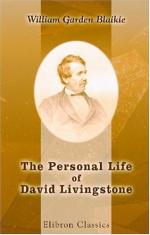“Our native assistant Mebalwe has been of considerable value to the Mission. In endeavoring to save my life he nearly lost his own, for he was caught and wounded severely, but both before being laid aside, and since his recovery, he has shown great willingness to be useful. The cheerful manner in which he engages with us in manual labor in the station, and his affectionate addresses to his countrymen, are truly gratifying. Mr. E. took him to some of the neighboring villages lately, in order to introduce him to his work; and I intend to depart to-morrow for the same purpose to several of the villages situated northeast of this. In all there may be a dozen considerable villages situated at convenient distances around us, and we each purpose to visit them statedly. It would be an immense advantage to the cause had we many such agents.”
Another proof that his pleas for native agency, published in some of the Missionary Magazines, were telling at home, was the receipt of a contribution for the employment of a native helper, amounting to L15, from a Sunday-school in Southampton. Touched with this proof of youthful sympathy, Livingstone addressed a long letter of thanks to the Southampton teachers and children, desiring to deepen their interest in the work, and concluding with an account of his Sunday-school:
“I yesterday commenced school for the first time at Mabotsa, and the poor little naked things came with fear and trembling. A native teacher assisted, and the chief collected as many of them as he could, or I believe we should have had none. The reason is, the women make us the hobgoblins of their children, telling them ’these white men bite children, feed them with dead men’s brains, and all manner of nonsense. We are just commencing our mission among them.”
A new star now appeared in Livingstone’s horizon, destined to give a brighter complexion to his life, and a new illustration to the name Mabotsa. Till this year (1844) he had steadily repudiated all thoughts of marriage, thinking it better to be independent. Nor indeed had he met with any one to induce him to change his mind. Writing in the end of 1843 to his friend Watt, he had said: “There’s no outlet for me when I begin to think of getting married but that of sending home an advertisement to the Evangelical Magazine, and if I get very old, it must be for some decent sort of widow. In the meantime I am too busy to think of any thing of the kind.” But soon after the Moffats came back from England to Kuruman, their eldest daughter Mary rapidly effected a revolution in Livingstone’s ideas of matrimony. They became engaged. In announcing his approaching marriage to the Directors, he makes it plain that he had carefully considered the bearing which this step might have on his usefulness as a missionary. No doubt if he had foreseen the very extraordinary work to which he was afterwards to be called, he might have come to a different conclusion.




